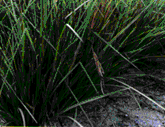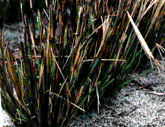Vetiver Grass - Vetiveria
zizanioides |
||
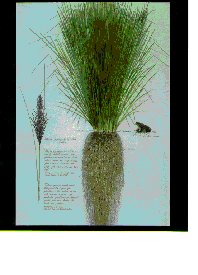 |
Vetiver grass is tough perennial clump grass that is as equally at home in wet swampy conditions as it is in well drained upland soils. It is tolerant to a wide range of pH from >3 to >10. Vetiver grass grows best under tropical and semi tropical conditions. It is unlikely to survive continuous frozen conditions. It has strong deep roots and tough dense leaves . Many cultivars of Vetiveria zizanioides do not flower, and thus do not seed. It is not considered a weed, and generally stays where planted. It is tolerant to fire and exhibits quick re-growth. | 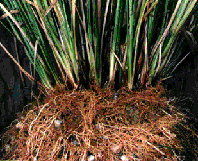 |
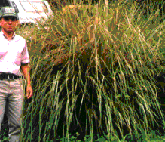 |
The left hand image is
a water color of vetiver by Anita Cooper and shows the large vertical root mass together
with a dense leaf area. The right hand image shows a close up of a two year old vetiver
clump. Note the root structure and dense and strong leaves and stems.The image on the left
is a two year old plant in western Panama grown for medicinal purposes. The plant on the
right is a single vetiver slip in Vietnam.
|
 |
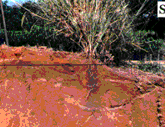   |
Many cultivars of vetiver,
particularly those originating from south India do not flower, and if they do the seed is
normally sterile. Some cultivars and varieties, e.g. V. lawsoni, are prolific
seeders. Vetiver is normally propagated by dividing the rhyzome into planting slips as
shown in photograph above from Vietnam. It is recommended to plant three slips per
planting station. This applies to both in field as well as nursery planting. In field
planting stations should be at 15 cm apart within the line, and in the nurseries planting
stations should be at 30 cm on the square. Vetiver grass' primary use is for soil and water conservation, embankment stabilization and wasteland rehabilitation. For these conservation purposes vetiver grass has to be planted as a hedge, if it is to perform satisfactorily. Hedges are planted on the contour, and if the technology is correctly applied, using good quality plant material, dense hedges will be formed that will slow down rainfall run off, and will trap sediment, resulting in increased ground water and soil moisture, reduced erosion, and better maintained soil fertility. Often crop yields improve sub stantially. |
|
| The above three photographs show cross -sections (center and right) of a vetiver hedge as well as longitudinal section (left) through a hedge. In all cases note the dense and strong root structures. The cross section photographs show how the erosion sediment has built up behind the hedges and the subsequent change in slope as natural terraces are formed. In future years runoff velocity will decrease and erosion rates will further be reduced | ||
These two phtographs show the effects of fire
on vetiver grass. The left hand image depicts the grass at 1 week after the fire, at the
right the grass is fully recovered at 4 weeks. |
||
